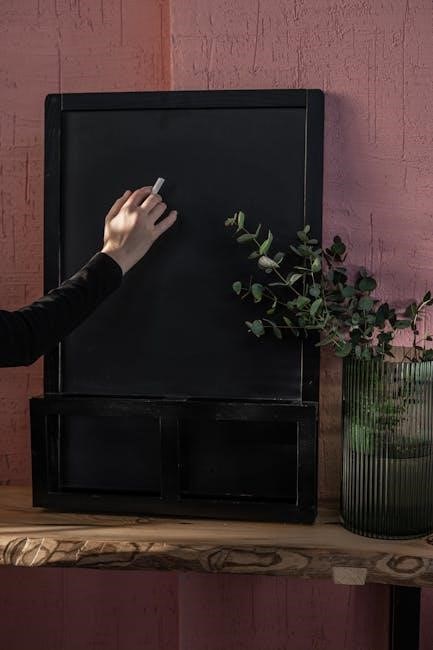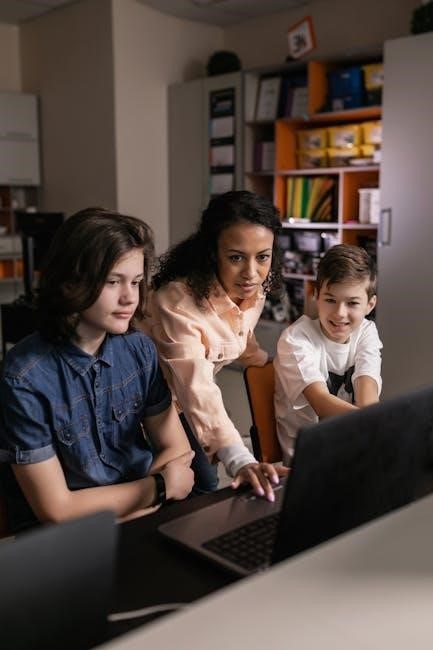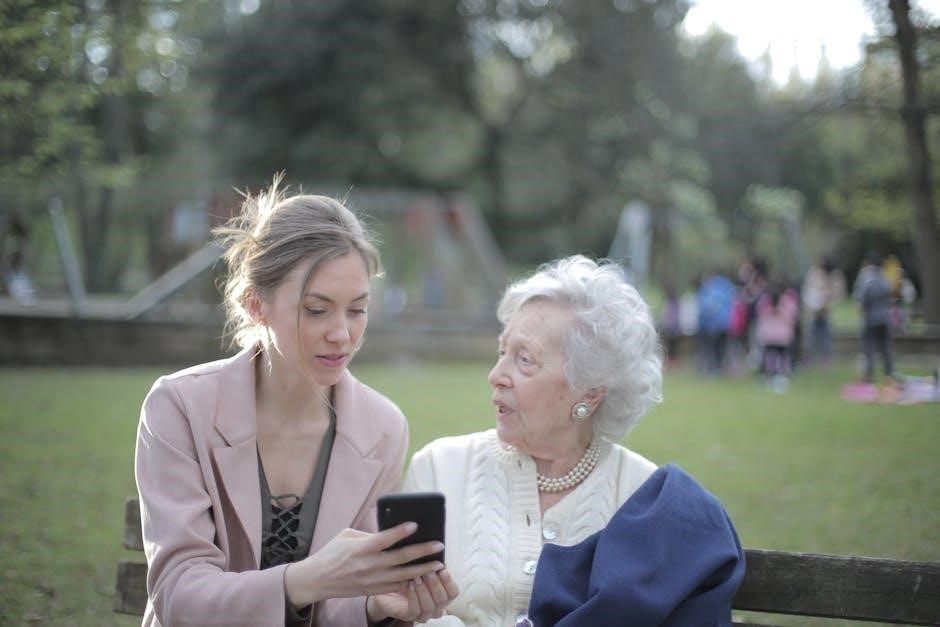Trick-or-treaters bring excitement and joy to neighborhoods, embodying the spirit of Halloween. Their visits are guided by simple instructions, like “ONEEACH,” ensuring fun and safety for all.
Understanding the Tradition of Trick-or-Treating
Trick-or-treating is a beloved Halloween tradition where children visit homes, asking for treats. The phrase “trick or treat” reflects its origins in playful exchanges, with the “trick” serving as a lighthearted warning. Over time, the practice evolved into a family-friendly activity focused on candy and small gifts. Instructions like “ONEEACH,” as seen in the New York Times crossword, emphasize taking one treat per house, promoting fairness and moderation. Safety guidelines, such as carrying glow sticks and staying in groups, ensure a fun and secure experience for all. This tradition fosters community bonding, making Halloween a cherished event for both children and adults.
The Role of Instructions in Ensuring Safety and Fun
Instructions play a crucial role in making trick-or-treating both safe and enjoyable for everyone. Clear guidelines, such as taking only one piece of candy per house (as hinted by “ONEEACH” in the New York Times crossword), promote fairness and reduce conflicts. Parents often remind children to stay visible with glow sticks or reflective costumes, while homeowners are advised to prepare treats in advance. These instructions ensure that trick-or-treaters can focus on the excitement of the night without compromising safety. By following these simple rules, both children and adults can fully embrace the festive spirit of Halloween.

Historical Context of Trick-or-Treating
Trick-or-treating has roots in ancient festivals like Samhain, evolving over centuries into the modern practice of asking for treats while in costume.
Origins of Halloween and Trick-or-Treating
Halloween originates from the ancient Celtic festival of Samhain, marking the end of harvest and the beginning of winter. It was believed that on October 31, the boundary between the living and the dead blurred. The tradition of trick-or-treating evolved from the practice of “souling,” where poor individuals would receive food in exchange for praying for the dead. Over time, this transformed into children asking for treats while in costumes. Today, trick-or-treating remains a cornerstone of Halloween celebrations worldwide, blending ancient rituals with modern fun.
Evolution of Trick-or-Treating Practices Over Time
Trick-or-treating has evolved significantly from its origins in “souling” to modern practices. Initially, it involved offering prayers for the dead in exchange for food. By the mid-20th century, the tradition shifted to children in costumes visiting homes for candy. Suburbanization in the 1950s popularized door-to-door trick-or-treating, emphasizing community engagement. Today, practices vary widely, with some opting for “trunk-or-treat” events or grab-and-go stations. Instructions like “ONEEACH” ensure fairness and safety. Additionally, environmental and health concerns have led to alternatives, such as non-candy treats and eco-friendly options. These changes reflect cultural shifts while preserving the festive spirit of Halloween.

Key Safety Instructions for Trick-or-Treaters

Trick-or-treaters should prioritize visibility with glow sticks or reflective costumes. Staying in groups and avoiding strangers ensures safety; Always check candy before eating to avoid harmful items.
Importance of Visibility and Glow Sticks
Visibility is crucial for trick-or-treaters to ensure they are seen by drivers and others. Glow sticks, reflective costumes, and flashlights significantly enhance safety. They make children more visible in low-light conditions, reducing the risk of accidents. Glow sticks are particularly effective because they are easy to carry and provide a bright, continuous light source. Encouraging kids to use these tools helps parents and caregivers feel more confident about their safety. Additionally, visibility aids like reflective tape on costumes or trick-or-treat bags can further improve awareness. By prioritizing visibility, families can enjoy a safer and more enjoyable Halloween experience. Always remind children to stay in well-lit areas and avoid dark paths.
Stay in Groups and Avoid Strangers
Trick-or-treaters should always stay in groups and avoid interacting with strangers. This ensures their safety and reduces potential risks. Accompanying adults or older siblings can provide supervision, especially for younger children. Teach kids to never enter strangers’ homes or accept rides. Encourage them to stay on well-lit streets and avoid dark or isolated areas. Carrying a phone or having a parent nearby adds an extra layer of security. Glow sticks or flashlights can also help others see them, further enhancing safety. Remind children to only visit houses with porch lights on, as this indicates the homeowner is welcoming trick-or-treaters. Stay alert and report any suspicious behavior to adults or authorities. Always prioritize group safety and awareness.
Check Candy Before Consumption
Parents should inspect all candy and treats before allowing children to eat them. Look for signs of tampering, such as open wrappers, torn packaging, or unusual appearance. Teach kids not to consume anything until it’s checked. Discard any items that seem suspicious or unsafe. Some candies may cause allergies, so verify ingredients if necessary. Homemade treats from unknown sources should be avoided. Encourage children to only collect candy from trusted neighbors or organized events. This routine ensures a safe and enjoyable Halloween experience for all trick-or-treaters. Always prioritize safety over the excitement of collecting treats. Stay vigilant and take all precautions seriously.

Creative Instructions for a Memorable Experience
Themed costumes and props enhance the fun, while trick-or-treat bags or pails add a practical touch. Incorporating games and activities keeps the experience engaging and enjoyable for all.
Themed Costumes andProps to Enhance Fun
Themed costumes and props are essential for creating a memorable Halloween experience. They allow trick-or-treaters to express their creativity and fully immerse themselves in the festive spirit. Families often choose coordinating outfits, such as superheroes or movie characters, to make the evening more enjoyable. Props like wands, masks, and fake weapons can add depth to their costumes, making photos and interactions more dynamic. Many parents encourage their kids to craft DIY accessories, fostering creativity and excitement. These themed elements not only enhance fun but also make the trick-or-treating tradition more personal and engaging for everyone involved.

Using Trick-or-Treat Bags or Pails
Trick-or-treat bags or pails are a Halloween essential, allowing children to collect candy safely and efficiently. Many families opt for themed bags featuring popular characters or spooky designs, adding to the festive atmosphere. These bags are often durable and easy to carry, ensuring kids can haul their treats without hassle. Some parents prefer reusable pails or buckets, which are eco-friendly and can be used year after year. Trick-or-treat bags also serve as a practical way to organize candy, making it easier for parents to inspect treats later. They’re a simple yet vital part of the Halloween tradition, enhancing both fun and functionality for trick-or-treaters.
Incorporating Games and Activities
Incorporating games and activities enhances the Halloween experience for trick-or-treaters, adding entertainment beyond collecting candy. Many families and communities organize themed games like pumpkin scavenger hunts or costume contests. These activities create bonding moments and keep children engaged while they trick-or-treat. Some neighborhoods also set up trick-or-treat obstacle courses or spooky-themed challenges, making the night more interactive. Additionally, parents often include post-trick-or-treat games at home, such as sorting candy or guessing the number of treats collected. These playful elements ensure a memorable and enjoyable Halloween for kids, transforming it into a holistic celebration of fun, creativity, and community spirit.

Community Instructions for Homeowners
Homeowners should prepare for trick-or-treaters by stocking candy, ensuring a clear walkway, and using signs to guide visitors, fostering a safe and welcoming environment.
Preparing Candy and Treats
Preparing candy and treats for trick-or-treaters involves selecting a variety of options, including chocolates, candies, and non-candy items. Many homeowners opt for individually wrapped treats to ensure safety and hygiene. Some also consider offering healthier alternatives or small toys, catering to dietary restrictions. It’s essential to have enough stock to accommodate all visitors. Additionally, organizing treats in bowls or containers with clear labels can help children make easy choices. Proper storage and handling of candies are crucial to maintain freshness and safety. Homeowners often start preparing weeks in advance to avoid last-minute shortages, ensuring a smooth and enjoyable experience for all trick-or-treaters.
Creating a Welcoming Environment
Creating a welcoming environment for trick-or-treaters involves setting the right tone with decorations and lighting. Homeowners often illuminate their porches and pathways to ensure visibility and safety. Decorations like jack-o’-lanterns, spider webs, and themed displays add to the festive atmosphere. Clear signage, such as “Trick-or-Treaters Welcome,” can guide children to the front door. Maintaining a clean and well-lit entryway is essential to make visitors feel comfortable. Some families also play Halloween-themed music to enhance the experience. By creating an inviting space, homeowners contribute to a positive and memorable night for all trick-or-treaters. This thoughtful preparation ensures a delightful interaction for both kids and adults alike;
Alternative Options for Non-Candy Items
For those looking to offer alternatives to candy, options like toothbrushes, raisins, or small toys are popular choices. These items cater to children with dietary restrictions or allergies, ensuring inclusivity. Many homeowners opt for non-candy treats to promote healthier habits or eco-friendly practices. Stickers, pencils, or erasers are also fun alternatives that kids enjoy. Some families even offer mini toiletries or trinkets, adding a unique twist to trick-or-treating. By providing non-candy items, households can still participate in the tradition while addressing modern concerns about sugar intake and environmental impact. Clear signage can help guide trick-or-treaters to these alternative treats, making the experience enjoyable for everyone.

Modern Twists on Trick-or-Treating
Modern twists include grab-and-go stations, trunk-or-treat events, and virtual trick-or-treating, offering safe and innovative ways to celebrate Halloween while maintaining tradition and excitement for participants.
Grab-and-Go Candy Stations
Grab-and-go candy stations are a modern twist on traditional trick-or-treating, offering a convenient and safe way for children to collect treats. These stations, often set up on porches or in driveways, allow kids to pick their own candy without direct contact, reducing germ exposure. They’re especially popular in neighborhoods with high volumes of trick-or-treaters or in areas where time is limited. Parents appreciate the efficiency, while kids enjoy the independence of selecting their own snacks. This approach maintains the festive spirit of Halloween while addressing contemporary concerns about safety and hygiene, making it a practical choice for many families.
Trunk-or-Treat Events
Trunk-or-Treat events are a popular alternative to traditional trick-or-treating, offering a fun and safe environment for children to collect candy. Participants gather in a parking lot, where car trunks are decorated with creative themes and filled with treats. Kids move from car to car, enjoying the festive atmosphere while collecting candy. These events are often organized by communities, schools, or churches, providing a controlled setting for families. The trunk decorations add an extra layer of excitement, turning the event into a celebration of creativity and community spirit. Trunk-or-Treat is especially appealing to parents seeking a secure and organized way for their children to enjoy Halloween;
Virtual Trick-or-Treating Options
Virtual trick-or-treating offers an innovative way to celebrate Halloween, especially for those who cannot participate in person. Online platforms allow kids to trick-or-treat digitally, with virtual doors to knock on and candy to collect. Parents can create accounts for their children, who then interact with virtual neighbors or friends; Some apps and websites feature augmented reality elements, enhancing the experience. This option is ideal for families seeking a safe, weather-free alternative. Virtual events also promote inclusivity, enabling children with disabilities or those in remote areas to join in the fun. Instructions are provided online, ensuring a smooth and enjoyable experience for all participants.

Environmental Considerations
Eco-friendly alternatives to traditional treats and mindful waste reduction are essential for a sustainable Halloween. Choose biodegradable or reusable items to minimize environmental impact while celebrating.
Eco-Friendly Treat Options
Eco-friendly treats are a thoughtful choice for trick-or-treaters, promoting sustainability. Opt for biodegradable candies, organic snacks, or non-food items like pencils. These options reduce waste and environmental impact.
Reducing Waste During Halloween
Reducing waste during Halloween involves mindful practices like using reusable trick-or-treat bags and eco-friendly decorations. Opt for recyclable materials and avoid single-use plastics. Composting leftover food and donating unused candy can minimize landfill contributions. Encourage community events where kids trick-or-treat in central locations, reducing individual packaging waste. Educating families on sustainable choices helps create a greener Halloween tradition. Small changes can make a significant impact on reducing environmental footprint while keeping the holiday spirit alive.

Instruction to Trick-or-Treaters NYT Crossword Clue
The clue “ONEEACH” instructs trick-or-treaters to take one candy each, ensuring fairness and managing candy distribution efficiently during Halloween.
Understanding the Clue “ONEEACH”
The crossword clue “ONEEACH” refers to a simple yet effective instruction for trick-or-treaters: take one piece of candy each. This ensures fairness and prevents overconsumption, promoting polite behavior during Halloween. Homeowners often use signs with this instruction to manage candy distribution efficiently, making the process enjoyable for both kids and adults; It aligns with safety guidelines, helping to maintain order and reduce waste. This clue has appeared in The New York Times crossword, highlighting its relevance to modern Halloween practices. By following “ONEEACH,” everyone can enjoy the festive spirit responsibly.
Relevance of the Clue to Halloween Practices
The clue “ONEEACH” directly ties into modern Halloween customs, emphasizing polite and orderly candy collection. By instructing trick-or-treaters to take one piece each, it promotes fairness and reduces waste. This approach aligns with contemporary practices like grab-and-go candy stations and trunk-or-treat events, where efficiency and safety are prioritized. The clue also reflects the broader cultural shift toward mindful consumption and organized celebrations. As Halloween evolves, such instructions help maintain a fun yet respectful atmosphere, ensuring everyone enjoys the holiday without excess or chaos. This simple guideline embodies the spirit of Halloween, blending tradition with practicality for a smoother experience.
The instruction to trick-or-treaters, like “ONEEACH,” ensures a safe, enjoyable Halloween. These guidelines promote fairness, reducing waste and fostering a respectful celebration for all participants.
Summarizing the Key Points
The instruction to trick-or-treaters, such as “ONEEACH,” ensures fairness and moderation in candy collection. Safety guidelines like visibility, group outings, and candy checks are essential. Creative elements, including themed costumes and eco-friendly treats, enhance the experience. Modern practices like grab-and-go stations and virtual trick-or-treating offer convenient alternatives. Homeowners play a crucial role by preparing treats and creating welcoming environments. Environmental considerations, such as reducing waste, promote sustainability. These practices foster a respectful and enjoyable Halloween celebration for both trick-or-treaters and the community, ensuring a fun and safe experience for all.
Final Tips for a Successful Halloween
To ensure a successful Halloween, trick-or-treaters should follow instructions like “ONEEACH” to maintain fairness. Parents should emphasize safety by using glow sticks and staying in groups. Checking candy before consumption is crucial. Homeowners can create a welcoming environment with clear signs and alternative treats. Incorporating eco-friendly options reduces waste. Modern twists, such as grab-and-go stations, offer convenience. Encourage creativity with themed costumes and props. Plan activities like pumpkin carving or movie nights for added fun. By combining these tips, everyone can enjoy a safe, enjoyable, and memorable Halloween experience. Happy trick-or-treating!
